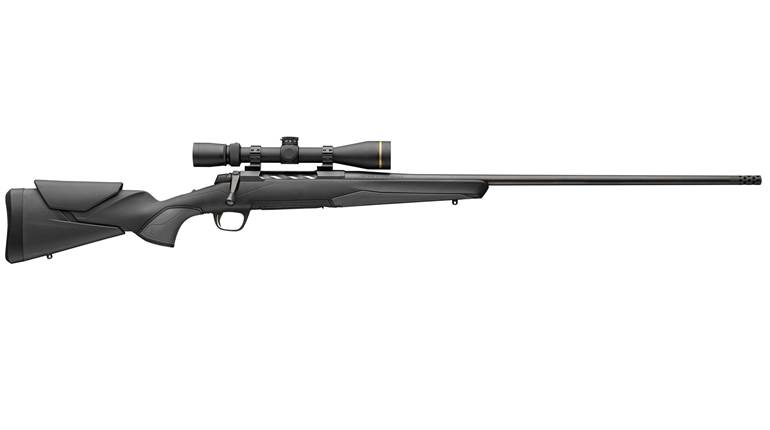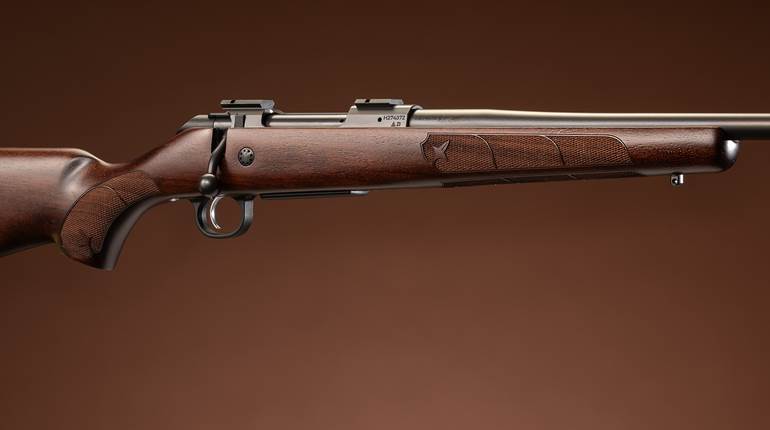
Weatherby has a long and rich history of innovation. A dedicated hunter and amateur ballistician, Roy Weatherby discovered in the 1940s that pushing lighter bullets to hyper velocities would result in effective game kills. He developed his legendary Mark V rifle to contain his powerful wildcat cartridges and his well-heeled clientele went afield with their Monte Carlo stocked rifles. In the 1970s the Vanguard rifle was developed and suddenly owning a Weatherby was within the reach of the average hunter. The Weatherby name has always been synonymous with quality and known worldwide by sportsmen. Lesser known is Weatherby’s line of tactical precision rifles.
Weatherby Shooting Systems is a collection of bolt guns configured for tactical use. Utilizing the proven Mark V and Vanguard actions, these rifles are offered in a host of calibers and stocks designed to produce precision accuracy at extended distances. I received a sample of the Vanguard Modular Chassis (VMC) rifle chambered in .308 Win.
Designed for precision long-range shooting, the VMC has a number of features that make it appropriate for competition and law enforcement work. Weatherby starts with its Vanguard action fitted with a 22” heavy barrel and a Modular Driven Technologies (MDT) aluminum chassis stock, match grade 2-stage trigger and Luth AR MBA buttstock. The VMC also uses a 10-round detachable polymer magazine.
The Vanguard action has a reputation for strength, and was the logical choice for Weatherby to base the VMC rifle on. The one-piece machined receiver features an integral recoil lug for strength and structural integrity. The machined one-piece bolt body is fluted and the bolt sleeve is fully enclosed. There are three ports drilled into the bolt body to redirect gas in the event of a case rupture or blown primer. The bolt has twin locking lugs, a claw extractor and a plunger-style ejector on the bolt face. The action is push-feed in operation and did not require Weatherby engineers to alter the bolt to feed from the detachable single-stack magazine. It cocks on opening and is so smooth that I used my trigger pull gauge to determine that it only requires 7 lbs. of upward force to open and cock the action. Before I took the VMC to the range I put a few drops of oil on the bolt raceways but I’m not really sure I needed to. The action is incredibly smooth!
Weatherby outfits the VMC with a heavy barrel which measures about 1” at the receiver and tapers to .74” at the muzzle. Its length is 22” and it is rifled with a 1:10” twist, cold hammer forged and has a recessed target crown for protection. For accuracy’s sake the barrel is free-floated its entire length.
The MDT chassis is machined from 6061 aluminum and hard anodized. Only two screws are required to marry the Vanguard barreled action to the MDT stock. At the front of the elongated trigger guard is a lever-type magazine release. Pushing it forward will release the 10-round polymer mag. The rear of the chassis is threaded to accept an AR receiver extension (buffer tube) and Weatherby uses the Luth AR MBA-1 stock. This lightweight, glass-filled nylon stock delivers a full 1” of height on the cheek rest and 1 1/16” adjustability on length of pull. All adjustments are easy to make and securely retain their positions. I like it because the inside curve of the stock gives the shooter a place for the off hand to pull the stock tightly into the shoulder when shooting from a rest. A Hogue over-molded pistol grip is used on the VMC.
A three-position manual safety is located at the rear, right-side of the VMC action. With the safety at its rearmost position, it blocks the sear and locks the bolt handle. The middle position still blocks the sear but allows the bolt to be manipulated, and would be the position used to load and unload the VMC. Pushing the safety to its forward most position will allow the user to fire.
A match grade, 2-stage, adjustable trigger is used on the VMC. To adjust the trigger, remove the two action screws and separate the barreled action from the chassis. At the front of the trigger mechanism is a lock nut which must be loosened before an adjustment can be made. Turning the screw clockwise will increase the trigger pull. I adjusted the trigger pull to 2.75 lbs. and retightened the lock nut and reinstalled the action in the chassis.
I received the VMC without any mounting hardware for optics and when I requested a scope base I received something even better. Vanguard lightweight mounts are made from 7000 series extruded billet alloy, CNC machined to exacting tolerances. The one-piece mount and ring provides more strength and durability than steel rings and bases yet they only weigh 3 ozs. per pair. It took just a minute to install them on the receiver top and then I mounted a Pentax Lightseeker 6-24X 50 mm scope and was ready to fire some groups.
I arrived at the range at 7 a.m. and it was still relatively cool as I set up my sight-in target at 50 yards. This is when I started to get excited—each of my three sighting groups were three shots all touching each other. Once I had the zero I moved the target back to 100 yards. Weatherby offers a 1 MOA guarantee with its Vanguard rifles but I soon found out the VMC was actually capable of much better. All groups were fired from a seated rest, utilizing a Caldwell rifle rest for support. Five shots were fired to each group and the accuracy chart shows the best group fired with each ammunition. No effort was given to allowing the barrel to cool between groups.
|
AMMO |
VELOCITY |
ENERGY |
GROUP |
|
Black Hills 168-gr. BTHP |
2608 |
2537 |
.57” |
|
Black Hills 175-gr. BTHP |
2603 |
2633 |
.76” |
|
Federal Premium MatchKing 168-gr. BTHP |
2659 |
2638 |
.66” |
|
Hornady 155-gr. Steel Match |
2612 |
2348 |
.55” |
|
Hornady 155-gr. American Gunner |
2697 |
2504 |
.70” |
|
Hornady Match 168-gr. BTHP |
2718 |
2756 |
.53” |
All groups were fired from a seated rest utilizing a Caldwell rifle rest for support. Velocities were recorded with a Pact chronograph and are listed in feet per second. Energies are listed in foot pounds of energy.
My single best group was fired with Hornady’s Match 168-gr. BTHP ammunition. Five shots measured just slightly more than a half-inch. Hornady’s 155-gr. Steel Match ammo wasn’t far behind with a group of .55”. The Pentax Lightseeker provided an incredibly bright and clear sight picture for me and made quartering the little 2” Shoot N C targets easy—even at 100 yards. Also accounting for the small groups is the VMC’s wonderful trigger. It is a two-stage affair and the first stage has about 3/8” take up with about a pound of pressure until it reaches the second stage where another 1 ¾ lbs. was required to break the shot. I’d take up the first stage as I prepped my shot and when I had everything lined up added more pressure until the rifle fired.

All rounds fed and fired without any problems. Even when I worked the bolt slowly, the empty cases were flung with authority from the rifle’s action. None of the loads listed required extra effort to open the bolt. Rounds fed with buttery fluidity from the polymer 10-round magazine and there was no binding or impingement of any kind.
The Weatherby VMC is one of those guns that is a joy to test. It is amazingly accurate and 100 percent reliable. Despite this I did have a couple of minor suggestions. I’d like to see Weatherby offer this model with an oversized and weighted bolt handle for speedy manipulation. I don’t think this would be difficult or expensive for them to do and would make the gun more attractive for competitors and law enforcement alike. In a conversation with a Weatherby official, I mentioned that offering this rifle in 6.5 Creedmoor with a threaded barrel would be especially appealing to those interested in precision long-range shooting. His response was that they are working on such a gun.
While many consider Weatherby to be a manufacturer of hunting rifles, it should not be overlooked by those searching for long-range precision rifles. Whether for use by competition shooters or law enforcement operators the Vanguard Modular Chassis rifle is capable of surgical precision and possesses unerring reliability. For more information on the Vanguard and the rest of the Weatherby Shooting Systems visit Weatherby.com.
NRA Specifications
Manufacturer: Weatherby
Model: Vanguard Modular Chassis
Caliber: .308 Win.
Capacity: 10 + 1, Polymer Detachable Magazine
Stocks: MDT Chassis, Luth AR MBA-1 Buttstock, Hogue Pistol Grip
Trigger: 2-Stage Adjustable
Barrel: Cold Hammer Forged, 22”, 1:10” Twist, Recessed Target Crown
Weight: 8.75 lbs.
Overall Length: 41.25-42.25”
MSRP: $1,449






































